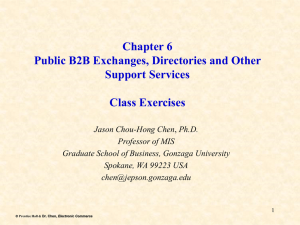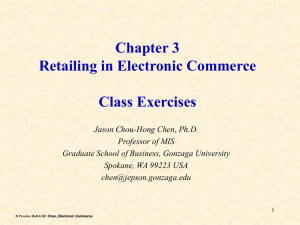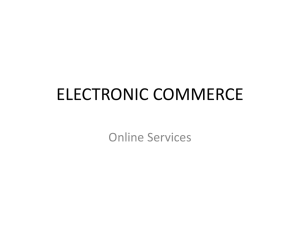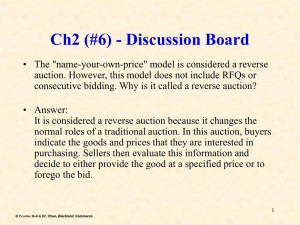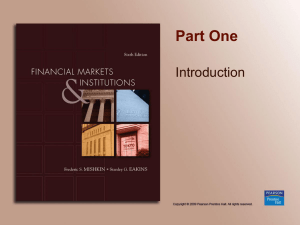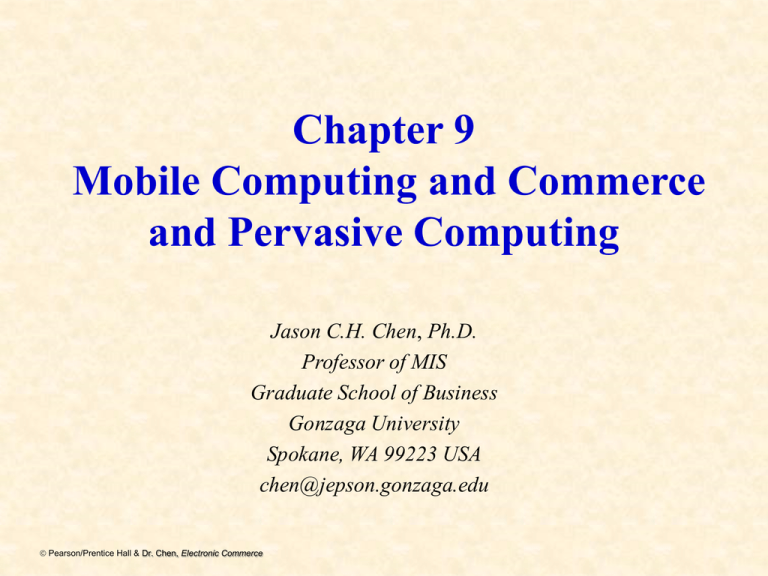
Chapter 9
Mobile Computing and Commerce
and Pervasive Computing
Jason C.H. Chen, Ph.D.
Professor of MIS
Graduate School of Business
Gonzaga University
Spokane, WA 99223 USA
chen@jepson.gonzaga.edu
Pearson/Prentice Hall & Dr. Chen, Electronic Commerce
Learning Objectives
1. Describe the mobile computing environment that supports
m-commerce (devices, software, services).
2. Describe the four major types of wireless
telecommunications networks.
3. Define mobile commerce and understand its relationship
to e-commerce.
4. Discuss the value-added attributes, benefits, and
fundamental drivers of m-commerce.
5. Discuss m-commerce applications in finance, shopping,
advertising, and provision of content.
6. Describe the application of m-commerce within
organizations.
Pearson/Prentice Hall & Dr. Chen, Electronic Commerce
Learning Objectives
7. Understand B2B and supply chain management
applications of m-commerce.
8. Describe consumer and personal applications of
m-commerce.
9. Understand the technologies and potential
application of location-based m-commerce.
10. Describe the major inhibitors and barriers of mcommerce.
11. Discuss the key characteristics and current uses
of pervasive computing.
Pearson/Prentice Hall & Dr. Chen, Electronic Commerce
9.1 Mobile Computing:
Content, Infrastructure, and Services
• New Computing Environment: Mobile
Computing
– Mobile devices
• personal digital assistant (PDA)
A handheld computer principally used for personal information
management
• smartphone
Internet-enabled cell phone that can support mobile
applications
• Blackberry
A handheld device principally used for e-mail
Pearson/Prentice Hall & Dr. Chen, Electronic Commerce
Mobile Computing:
Content, Infrastructure, and Services
Pearson/Prentice Hall & Dr. Chen, Electronic Commerce
Mobile Computing:
Content, Infrastructure, and Services
– Conversion of devices
• These handheld devices blend blogging, Instant
Messages, SMS, and other forms of social
networking in which Web browsing is easy,
especially with a full keyboard
– wireless mobile computing (mobile
computing)
Computing that connects a mobile device to a
network or another computing device, anytime,
anywhere
Pearson/Prentice Hall & Dr. Chen, Electronic Commerce
Mobile Computing:
Content, Infrastructure, and Services
• Enabling Technologies for Mobile
Computing
– Hardware and software infrastructures that
support the wireless connection include
• Network access points
• Mobile communications server switches
• Cellular transmitters and receivers
Pearson/Prentice Hall & Dr. Chen, Electronic Commerce
Mobile Computing:
Content, Infrastructure, and Services
• Mobile Computing Software
– Mobile operating system
– Mobile application user interface
– microbrowser
Wireless Web browser designed to operate with small
screens and limited bandwidth and memory
requirements
– Wireless Application Protocol (WAP)
A suite of network protocols designed to enable
different kinds of wireless devices to access WAP
readable files on an Internet-connected Web server
Pearson/Prentice Hall & Dr. Chen, Electronic Commerce
Mobile Computing:
Content, Infrastructure, and Services
Pearson/Prentice Hall & Dr. Chen, Electronic Commerce
Mobile Computing:
Content, Infrastructure, and Services
– Markup languages
• Wireless Markup Language (WML)
A scripting language used to create content in the WAP
environment; based on XML, minus unnecessary
content to increase speed
• Compact Hypertext Markup Language (cHTML)
A scripting language used to create content in
i-mode
Pearson/Prentice Hall & Dr. Chen, Electronic Commerce
Mobile Computing:
Content, Infrastructure, and Services
– Extensible Hypertext Markup Language
(xHTML)
A general scripting language; compatible with
HTML; a standard set by W3 Consortium
– voice XML (VXML)
An extension of XML designed to
accommodate voice
Pearson/Prentice Hall & Dr. Chen, Electronic Commerce
Mobile Computing:
Content, Infrastructure, and Services
– Supporting devices
• synchronization
The exchange of updated information with other
computing devices
• Docking stations
• Attachable keyboards
• Batteries
• Media players
Pearson/Prentice Hall & Dr. Chen, Electronic Commerce
Mobile Computing:
Content, Infrastructure, and Services
• Mobile Computing Services
– Short Message Service (SMS)
A service that supports the sending and
receiving of short text messages on mobile
phones
– Enhanced Messaging Service (EMS)
An extension of SMS that can send simple
animation, tiny pictures, sounds, and formatted
text
Pearson/Prentice Hall & Dr. Chen, Electronic Commerce
Mobile Computing:
Content, Infrastructure, and Services
– Multimedia Messaging Service (MMS)
The emerging generation of wireless
messaging; MMS is able to deliver rich media
– micropayments
Electronic payments for small-purchase
amounts (generally less than $10)
Pearson/Prentice Hall & Dr. Chen, Electronic Commerce
Mobile Computing:
Content, Infrastructure, and Services
– Location-based services
• global positioning system (GPS)
A worldwide satellite-based tracking system that enables users
to determine their position anywhere on the earth
– Voice-support services
• interactive voice response (IVR)
A voice system that enables users to request and receive
information and to enter and change data through a telephone
to a computerized system
• voice portal
A Web site with an audio interface that can be accessed
through a telephone call
Pearson/Prentice Hall & Dr. Chen, Electronic Commerce
9.2 Wireless Telecommunications
Networks
• personal area network (PAN)
A wireless telecommunications network for
device-to-device connections within a very
short range
• Bluetooth
A set of telecommunications standards that
enables wireless devices to communicate
with each other over short distances
Pearson/Prentice Hall & Dr. Chen, Electronic Commerce
Wireless Telecommunications
Networks
• Wireless Local Area Networks and Wi-fi
– wireless local area network (WLAN)
A telecommunications network that enables users
to make short-range wireless connections to the
Internet or another network
– Wi-Fi (wireless fidelity)
The common name used to describe the IEEE
802.11 standard used on most WLANs
Pearson/Prentice Hall & Dr. Chen, Electronic Commerce
Wireless Telecommunications
Networks
– 802.11b
The most popular Wi-Fi standard; it is inexpensive and
offers sufficient speed for most devices; however,
interference can be a problem
– 802.11a
This Wi-Fi standard is faster than 802.11b but has a
smaller range
– 802.11g
This fast but expensive Wi-Fi standard is mostly used in
businesses
Pearson/Prentice Hall & Dr. Chen, Electronic Commerce
Wireless Telecommunications
Networks
– wireless access point
An antenna that connects a mobile device to a
wired LAN
– hotspot
An area or point where a wireless device can
make a connection to a wireless local area
network (using Wi-Fi)
Pearson/Prentice Hall & Dr. Chen, Electronic Commerce
Wireless Telecommunications Networks
Pearson/Prentice Hall & Dr. Chen, Electronic Commerce
Wireless Telecommunications
Networks
• Municipal Wi-fi Networks
– WiMax
A wireless standard (IEEE 802.16) for making
broadband network connections over a medium size
area such as a city
– wireless metropolitan area network (WMAN)
A telecommunications network that enables users to
make medium-range wireless connections to the
Internet or another network
Pearson/Prentice Hall & Dr. Chen, Electronic Commerce
Wireless Telecommunications
Networks
Pearson/Prentice Hall & Dr. Chen, Electronic Commerce
Wireless Telecommunications
Networks
• WIRELESS WIDE AREA NETWORKS
– wireless wide area network (WWAN)
A telecommunications network that offers wireless
coverage over a large geographical area, typically over
a cellular phone network
– Physical topology of a WWAN
• subscriber identification module (SIM) card
An extractable storage card used for identification, customer
location information, transaction processing, secure
communications, etc.
Pearson/Prentice Hall & Dr. Chen, Electronic Commerce
Wireless Telecommunications
Networks
– WWAN communication bandwidths
• 1G
The first generation of wireless technology, which
was analog based
• 2G
The second generation of digital wireless
technology; accommodates voice and text
• 2.5G
An interim wireless technology that can
accommodate voice, text, and limited graphics
Pearson/Prentice Hall & Dr. Chen, Electronic Commerce
Wireless Telecommunications
Networks
– 3G
The third generation of digital wireless technology;
supports rich media such as video
– 3.5G
This generation was inserted into the ranks of cell
phone generations; it refers to the packet-switched
technologies used to achieve higher transmission
speeds
– 4G
The expected next generation of wireless technology
that will provide faster display of multimedia
Pearson/Prentice Hall & Dr. Chen, Electronic Commerce
Wireless Telecommunications
Networks
– WWAN communication protocols
• Frequency Division Multiple Access (FDMA)
• Time Division Multiple Access (TDMA)
• Code Division Multiple Access (CDMA)
– WWAN network systems
• Global System for Mobile Communications
(GSM)
An open, nonproprietary standard for mobile voice
and data communications
Pearson/Prentice Hall & Dr. Chen, Electronic Commerce
9.3 Mobile Commerce:
Attributes, Benefits, and Drivers
• Mobile commerce (m-commerce, mbusiness):
Any e-commerce done in a wireless
environment, especially via the Internet
– A natural extension of e-business
– Mobile devices create an opportunity to
deliver new services to existing customers
Pearson/Prentice Hall & Dr. Chen, Electronic Commerce
Mobile Commerce:
Attributes and Benefits
What are the two
major barriers?
• Specific attributes of m-commerce
Geography
Time
– Mobility : portability
– Broad reach : anytime, anywhere
• Benefits of value-added attributes
–
–
–
–
–
Ubiquity: real-time information
Convenience: new technologies
Instant connectivity: easily and quickly
Personalization: for individual consumers
Localization of products and services
(Location-based e-C; l-commerce)
Pearson/Prentice Hall & Dr. Chen, Electronic Commerce
Exhibit The Characteristics of M-Commerce
Characteristics
Value-added attributes
Product and service localization
Mobility
M-commerce
Product personalization
Ubiquity enhancement
Instant connectivity
Reachability
Convenience
Pearson/Prentice Hall & Dr. Chen, Electronic Commerce
Mobile Commerce:
Attributes, Benefits, and Drivers
Pearson/Prentice Hall & Dr. Chen, Electronic Commerce
Mobile Commerce:
Attributes, Benefits, and Drivers
• Drivers of M-Commerce
–
–
–
–
–
–
–
–
Widespread availability of more powerful devices
The handset culture
The service economy
Vendor’s push
The mobile workforce
Increased mobility
Improved price/performance
Improvement of bandwidth
Pearson/Prentice Hall & Dr. Chen, Electronic Commerce
9.4 Mobile Financial Applications
• Mobile Banking and Financial Services
– Customers can use their mobile handsets to access
account balances, pay bills, and transfer funds using
SMS
• Wireless Electronic Payment Systems
– Wireless payment systems transform mobile phones
into secure, self-contained purchasing support tools
capable of instantly authorizing payments over the
cellular network
– m-wallet (mobile wallet)
Technologies that enable cardholders to make purchases
with a single click from their wireless device
Pearson/Prentice Hall & Dr. Chen, Electronic Commerce
Mobile Financial Applications
Pearson/Prentice Hall & Dr. Chen, Electronic Commerce
Mobile Financial Applications
• Wireless Bill Payments
– A number of companies are now providing their
customers with the option of paying their bills
directly from a cell phone
– Closing the digital divide
• Using WWANs, mobile devices, and even regular
cell phones, are closing the digital divide in
developing countries such as China, India, and the
Philippines
Pearson/Prentice Hall & Dr. Chen, Electronic Commerce
Mobile Financial Applications:
Bill Payments
Pearson/Prentice Hall & Dr. Chen, Electronic Commerce
9.5 Mobile Shopping,
Advertising, and Content
• Wireless Shopping
– An increasing number of online vendors allow
customers to shop from wireless devices,
especially cell phones and PDAs
• Mobile and Targeted Advertising
– Knowing the real-time location of mobile users
and their preferences or surfing habits,
marketers can send user-specific advertising
messages to wireless devices
Pearson/Prentice Hall & Dr. Chen, Electronic Commerce
Mobile Shopping,
Advertising, and Content
• mobile portal
A customer interaction channel that
aggregates content and services for mobile
users
Pearson/Prentice Hall & Dr. Chen, Electronic Commerce
BREAK
• Application Case 9.1: MarketSource
Mobilizes Its Workforce (p.439)
Pearson/Prentice Hall & Dr. Chen, Electronic Commerce
9.6 Mobile Enterprise and Supply
Chain
• Support of Mobile Employees
– Mobile office
– sales force mobilization
The process of equipping sales force employees
with wireless Internet-enabled computing
devices
– Worker support in retailing
– Support in hospitals
– Support in operations
Pearson/Prentice Hall & Dr. Chen, Electronic Commerce
Mobile Enterprise and Supply Chain
–
–
–
–
Tracking employees
Job dispatch
Maintenance and repair at remote sites
wearable devices
Mobile wireless computing devices, attached to
various parts of employees, for employees who
work on buildings and other climbable
workplaces
Pearson/Prentice Hall & Dr. Chen, Electronic Commerce
Mobile Enterprise and Supply Chain
•
•
•
•
Supporting Other Types of Work
Customer and Partner Support
Non–Internet Enterprise Applications
B2B M-Commerce and Supply Chain
Management
Pearson/Prentice Hall & Dr. Chen, Electronic Commerce
9.7 Mobile Personal
and Consumer Service Applications
• Mobile Entertainment
– Mobile games and gambling
– Hands-free driving
• Wireless Telemedicine
• Other Mobile Computing Services for
Consumers
• Non–Internet Mobile Applications for
Consumers
Pearson/Prentice Hall & Dr. Chen, Electronic Commerce
9.8 Location-Based Mobile
Commerce
• Location-based mobile commerce (Lcommerce): M-commerce transactions
targeted to individuals in specific locations,
at specific times
• L-commerce offers:
– Safety: emergency service
– Convenience: what or who is nearby
– Productivity: optimize travel and time
Pearson/Prentice Hall & Dr. Chen, Electronic Commerce
Location-Based Commerce (cont.)
L-commerce basic services revolve around five
key areas:
1. Location
determining the basic position of a person or a thing
2. Navigation
Plotting a route from one location to another
3. Tracking
Monitoring the movement of a person or a thing
4. Mapping
Creating maps of specific geographical locations
5. Timing
Determining the precise time at a specific location
Pearson/Prentice Hall & Dr. Chen, Electronic Commerce
Location-Based Mobile Commerce
• The Technology For L-Commerce
– Global positioning system
– geographical information system (GIS)
A computer system capable of integrating,
storing, editing, analyzing, sharing, and
displaying geographically-referenced (spatial)
information
– GPS/GIS applications
Pearson/Prentice Hall & Dr. Chen, Electronic Commerce
Location-Based Mobile Commerce
• Location-Based Advertising
• Emergency Response Cell Phone Calls
• wireless 911 (e-911)
In the United States, emergency response system that
processes calls from cellular phones
• automatic crash notification (ACN)
Device that automatically sends the police the
location of a vehicle that has been involved in a crash
Pearson/Prentice Hall & Dr. Chen, Electronic Commerce
Location-Based Mobile Commerce
• telematics
The integration of computers and wireless
communications to improve information
flow using the principles of telemetry
• Other Applications of Location-Based
Systems
Pearson/Prentice Hall & Dr. Chen, Electronic Commerce
Location-Based Mobile Commerce
• Barriers to Location-Based
M-Commerce
–
–
–
–
Accuracy of devices
The cost-benefit justification
Limited network bandwidth
Invasion of privacy
Pearson/Prentice Hall & Dr. Chen, Electronic Commerce
Location-Based Mobile Commerce (cont.)
Pearson/Prentice Hall & Dr. Chen, Electronic Commerce
Location-Based Mobile Commerce
(cont.)
• Barriers to L-commerce
–
–
–
–
Accuracy
The cost-benefit justification
The bandwidth of GSM networks
Invasion of privacy
Pearson/Prentice Hall & Dr. Chen, Electronic Commerce
9.9 Security and Other
Implementation Issues in M-Commerce
• M-Commerce Security Issues
–
–
–
–
–
–
Malicious codes
Transaction security
Wireless communication
Physical security of mobile devices
Ease of use and poor security
Security measures
Pearson/Prentice Hall & Dr. Chen, Electronic Commerce
Security and Other
Implementation Issues in M-Commerce
• Technological Barriers to
M-Commerce
– Many Web sites are not designed for viewing
by mobile devices
– Current devices have limited usability,
particularly with respect to pocketsize screens
or data input devices
– Quick and easy navigation of sites is necessary
but not always available in the mobile
environment
Pearson/Prentice Hall & Dr. Chen, Electronic Commerce
Security and Other
Implementation Issues in M-Commerce
• Ethical, Legal, and Health Issues in MCommerce
• Barriers for Enterprise Mobile
Computing
• Project Failures in M-Commerce
Pearson/Prentice Hall & Dr. Chen, Electronic Commerce
9.10 Pervasive Computing
• Pervasive computing: Invisible, everywhere
computing that is embedded in the objects
around us
• Also know as:
– ubiquitous computing
– embedded computing
– augmented computing
Pearson/Prentice Hall & Dr. Chen, Electronic Commerce
Pervasive Computing
• Principles of pervasive computing
Decentralization
Diversification
Connectivity
Simplicity
Pearson/Prentice Hall & Dr. Chen, Electronic Commerce
Pervasive Computing (cont.)
• Embedded computers do not intrude on our
consciousness
– Radio frequency identification (RFID):
Generic term for technologies that use radio
waves to automatically identify individual
items
– Contextual Computing
The enhancement of a user’s interactions by
understanding the user, the context, and the
applications and information required
Pearson/Prentice Hall & Dr. Chen, Electronic Commerce
Pervasive Computing
Pearson/Prentice Hall & Dr. Chen, Electronic Commerce
Pervasive Computing
– RFID Applications
•
•
•
•
•
Track moving vehicles
Track people
Track individual items
Protect secure areas
Record transactions
– Electronic Product Code (EPC)
An RFID code that identifies the manufacturer,
producer, version, and serial number of
individual consumer products
Pearson/Prentice Hall & Dr. Chen, Electronic Commerce
Pervasive Computing:
Applications
• Smart homes—home automation systems
support:
–
–
–
–
Lighting; Energy management
Water control; Home theater
Home security and communications
Home entertainment
• Smart appliances
Internet-ready appliance that can be controlled by a
small handheld device or desktop computer via a
home intranet or the public Internet
– Home Alliance (internethomealliance.com)
Pearson/Prentice Hall & Dr. Chen, Electronic Commerce
Pervasive Computing: Applications
(cont.)
• Smart cars—increased use of automobile
microprocessors
– sophisticated engine controls to meet emissions
and fuel-economy standards
– advanced diagnostics; simplification of the
manufacture and design of cars
– reduction of the amount of wiring in cars
– new safety features
– new comfort and convenience features
• Sensor network
– A series of interconnected sensors that monitor the
environment in which they are placed
Pearson/Prentice Hall & Dr. Chen, Electronic Commerce
Pervasive Computing
• Barriers to Pervasive Computing
– A number of technological, legal, and ethical
issues still need to be fully explored and
resolved if the promises of pervasive
computing are to be realized
Pearson/Prentice Hall & Dr. Chen, Electronic Commerce
BREAK-2
• Application Case 9.2: Wi-Fi Sensor Net
Aids Wine Makers (p.460)
Pearson/Prentice Hall & Dr. Chen, Electronic Commerce
Managerial Issues
1.
2.
3.
4.
5.
6.
What’s our timetable?
Which applications first?
Is it real or just a buzzword?
Which system to use?
Is an all-in-one device a winner?
Which will win the wireless race: WiMax,
Wi-Fi, or 3G?
Pearson/Prentice Hall & Dr. Chen, Electronic Commerce

